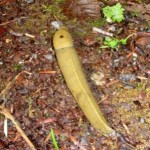
Digital News Report- The Aquarium of the Bay in San Francisco has added to land dwelling animals to their line up of exhibits. The California King Snake and the Banana Slug are part of “Slither: Invasion of the Land Animals” which will first be shown on Saturday, February 21 from 1-3pm. “Slither” is the first of five public events that will provide sneak peeks at the Aquariums new exhibits.
“Our new animals are taking Aquarium of the Bay to the next level — the above the ground level — as they are the first land-dwelling animals to make their homes here,” said CEO John Frawley. “We want to give our visitors a greater understanding of these animals’ habits and habitats, as well as how they are affected by environmental changes.”
The Banana Slug, Ariolimax columbianus, is in the Mollusca phylum, making them distant relatives to aquatic animals including octopuses and mussels. Banana slugs’ slime is essential in many ways: it helps them move; it serves as a protector against sharp rocks or other jagged surfaces and it plays a role in their respiration, as they breathe partially through the surface of their skin. They are most commonly found in redwood forests, where they eat savory foods such as wild mushrooms and less savory delicacies including fungi, and dead plant materials. Their hankering for such items makes Banana Slugs play an important role in maintaining a healthy forest food web, through their spreading of seeds and spores. Climate change could push the banana slug into excessive hibernation, making it unable to perform its essential job duties.
Another animal that moves via slithering, the California King Snake, Lampropeltis getula californiae, is found throughout the state in areas ranging from forests to fields, coastal scrub land to deserts. King Snakes are non venomous and kill prey including rodents, lizards and small mammals by squeezing them, similar to boa constrictors. The species can grow up to six-feet long and live more than 30 years. California King Snakes prefer to be active during cooler times of the day or warmer parts of the night, and are stressed by extreme temperatures. Drastic changes to California’s climate could cause the animal to go into extensive hibernation periods, preventing it from foraging for food.
